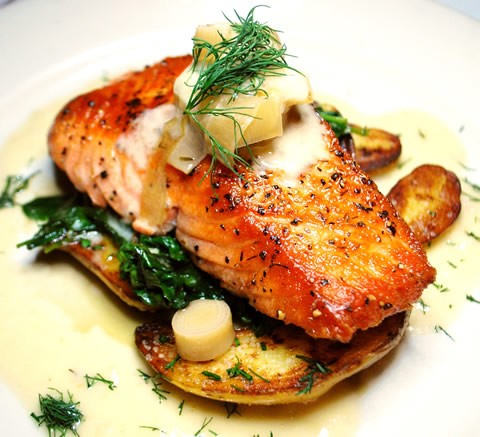 Our annual survey of seafood in Southeast Louisiana this year counts down the 33 best seafood species that we find more in restaurants than in homes. For the full survey so far,
click here. Or use the links at the bottom to move up and down the list.
Our annual survey of seafood in Southeast Louisiana this year counts down the 33 best seafood species that we find more in restaurants than in homes. For the full survey so far,
click here. Or use the links at the bottom to move up and down the list.
#25: Atlantic Salmon
 Salmon is the most widely-served fish in the fine restaurants of the world. It's highly thought of wherever it's found fresh. And that's just about everywhere these days, courtesy of fish farming and air shipping. Salmon is meaty, tasty, and easy to cook in myriad ways.
Edibly speaking, salmon fall into two categories: Atlantic and Pacific. They're different enough to appear twice in this countdown. The more common is the single Atlantic species, which occurs naturally throughout the northern Atlantic ocean on both sides. Atlantic salmon is also the one grown in fish farms--many of which, ironically, are in the Pacific Ocean. Around New Orleans, almost all of the salmon you see in stores and eat in restaurants is Atlantic. That's also the source of most smoked salmon, from Canada to Scandiavia.
New Orleans gained an appreciation for salmon only in recent decades. Until the 1980s, you found it in one of two forms--one wonderful and the other horrible. The good kind was cold-smoked as an appetizer in fancy, European-style restaurants and the then-rare kosher-style delis. The other kind was canned, a product so bad in comparison to any other fish that many older Orleanians still have an aversion to eating salmon.
The reason we now find salmon on so many New Orleans menus--even though it has to be brought in thousands of miles away--has as much to do with its convenience for the seller as with its goodness. It's always available, unlike most local fish. A restaurant can place a standing order for a certain amount of salmon every week and forget about it. For other fish, he has to work the market every day. If the only fish a restaurant offers is salmon, you are in a restaurant that doesn't put a lot of time into obtaining its raw materials. But it could be worse. It could have been tilapia.
Fortunately, fresh salmon, nicely cut, even if it comes from a farm, is pretty good. It's also easy to cook, particularly on the grill or under the broiler.
One other issue: the environmental problems associated with salmon farms. They mess up the water and introduce a foreign species, notably in the southern hemisphere. Another reason to eat local. Or at least knowledgeably.
Salmon is the most widely-served fish in the fine restaurants of the world. It's highly thought of wherever it's found fresh. And that's just about everywhere these days, courtesy of fish farming and air shipping. Salmon is meaty, tasty, and easy to cook in myriad ways.
Edibly speaking, salmon fall into two categories: Atlantic and Pacific. They're different enough to appear twice in this countdown. The more common is the single Atlantic species, which occurs naturally throughout the northern Atlantic ocean on both sides. Atlantic salmon is also the one grown in fish farms--many of which, ironically, are in the Pacific Ocean. Around New Orleans, almost all of the salmon you see in stores and eat in restaurants is Atlantic. That's also the source of most smoked salmon, from Canada to Scandiavia.
New Orleans gained an appreciation for salmon only in recent decades. Until the 1980s, you found it in one of two forms--one wonderful and the other horrible. The good kind was cold-smoked as an appetizer in fancy, European-style restaurants and the then-rare kosher-style delis. The other kind was canned, a product so bad in comparison to any other fish that many older Orleanians still have an aversion to eating salmon.
The reason we now find salmon on so many New Orleans menus--even though it has to be brought in thousands of miles away--has as much to do with its convenience for the seller as with its goodness. It's always available, unlike most local fish. A restaurant can place a standing order for a certain amount of salmon every week and forget about it. For other fish, he has to work the market every day. If the only fish a restaurant offers is salmon, you are in a restaurant that doesn't put a lot of time into obtaining its raw materials. But it could be worse. It could have been tilapia.
Fortunately, fresh salmon, nicely cut, even if it comes from a farm, is pretty good. It's also easy to cook, particularly on the grill or under the broiler.
One other issue: the environmental problems associated with salmon farms. They mess up the water and introduce a foreign species, notably in the southern hemisphere. Another reason to eat local. Or at least knowledgeably.
 Salmon Florentine
The color contrast of the green spinach with the pink-orange salmon is almost absurdly inviting. But the flavor of spinach and a good quality fresh salmon is itself very appealing. For this dish, locate the thickest salmon fillets you can, remove all the skin (not as hard as it looks--just have a sharp knife handy), and broil it just until it's warm all the way though.
Salmon Florentine
The color contrast of the green spinach with the pink-orange salmon is almost absurdly inviting. But the flavor of spinach and a good quality fresh salmon is itself very appealing. For this dish, locate the thickest salmon fillets you can, remove all the skin (not as hard as it looks--just have a sharp knife handy), and broil it just until it's warm all the way though.
- 2 10-oz. bags fresh spinach
- 4 salmon fillets, about 8 oz. each
- 6 Tbs. butter
- 1/4 tsp. dill
- Juice of 1/2 lemon
- 1/4 tsp. salt
- Pinch white pepper
- Pinch nutmeg
- 4 lemon slices
- 1/4 cup whipping cream
- Marinade:
- 1/4 cup extra-virgin olive oil
- 1/4 cup white wine
- 1 Tbs. lemon juice
- 1/2 tsp. Worcestershire sauce
- 1 tsp. soy sauce
- 2 dashes Tabasco